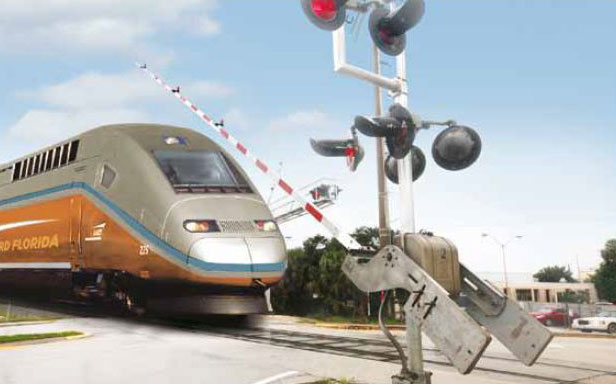
The eight railroad crossings within the city limits of Vero Beach were subjected to intense scrutiny Tuesday by a diagnostic team of engineers and railroad specialists.
The team – made up of representatives from All Aboard Florida, the city, the county, the metropolitan planning organization, Florida DOT, Florida East Coast Industries, and numerous consultants – came to determine what upgrades would be needed to enable the crossings to handle a second track and possibly qualify as Quiet Zones,.
Federal regulations require locomotives to sound their horns 15-20 seconds before a train arrives at a crossing, but no more than ¼ mile in advance of the crossing, and continue until the train reaches the crossing.
Quiet Zones, which are usually funded locally and not by a railroad, may be established to provide relief from the horn blowing if crossings within meet higher safety requirements.
AAF intends to upgrade the existing track and add a second track to handle the high speed trains that are proposed to run between Miami and Orlando, according to Rusty Roberts of Florida East Coast Industries.
However, AAF has no intention of improving the crossings within the City of Vero Beach, at 16th, 19th, 20th, 21st, 23rd, and 26th Streets, 14th Avenue, and Aviation Boulevard, to the level needed to qualify for Quiet Zones.
Roberts indicated that the diagnostic team will prepare a report for each crossing and outline what upgrades are needed to meet the lower standards for crossings where locomotive horns must be blown.
The completed reports will be provided to the city’s Director of Public Works in a few months. AAF will fund the design, construction, and construction management services needed for the crossings.
For the grade crossings to be further improved to meet Quiet Zone status, the local government would need to enter into cost sharing agreements with AAF. AAF would prefund the full cost of the higher level upgrades and the local governments would reimburse AAF for added costs to achieve Quiet Zone upgrades.
The 16th Street crossing is the one within the city of Vero Beach that will likely require the least upgrading.
The street has a raised median, although the median on the east side of the tracks is rather short and may need to be extended. Since 16th Street is relatively flat, not humped like 23rd Street and 14th Avenue as they cross the tracks, the roadwork would not extend much beyond the crossing.
Quad gates are required for a crossing to meet Quiet Zone qualifications. Long arms would have to come down from both the side of the road and the median to block each lane and each sidewalk on each approach entering and exiting the crossing. Although none of the crossings within Vero meet this criterion, the 16th Street crossing only lacks the exit gates.



